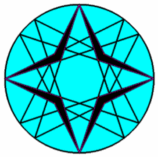nP-1: General information about Objects in an n-Point
For quick insight pictures of n-Points in EPG often are represented by figures bounded by n line-segments.
How many (n-1)-Points can be made up from an n-Point?
Many of the recursive constructions are based upon the property that from an n-Point exactly n different (n-1)-Points can be made up. This can easily be deduced by omitting one point from the n-Point. This will leave behind an (n-1)-Point. Since exactly n different Points can be omitted there will be n different (n-1)-Points contained in an n-Point. The (n-1)-Points in an n-Point will be called the Component (n-1)-Points. The remaining point after choosing an (n-1)-Point in an n-Point will be called the omitted point.
In descriptions we say “an n-Point contains n (n-1)-Points” or “an n-Point has n Component (n-1)-Points”. When we want to indicate different objects occurring in (n-1)-Points we say that there are n versions of these (n-1)P-objects.
The n versions of an object often will be noted with a suffix consisting of un underscore and a number 1, …, n, indicating the number of the omitted point. For example a 5-Point contains 5 4-Points and therefore has 5 4P-MVP-Centroids (4P-n-P1). They will be noted as 4P-n-P1_1, 4P-n-P1_2, 4P-n-P1_3, 4P-n-P1_4 and 4P-n-P1_5. The suffix number at the end is the number of the omitted point.
Recursive Eulerline situated points in an n-Point
There is a special way of construction of Eulerline points to a higher n-Point level.
This method is based upon the central property that from any n-Point n versions of (n-1)-Points can be constructed. The centroid of these n versions produce a higher level nP-point.
MVP Points: Multi Vector Points
| 3P-Point | 4P-Point | 5P-Point | 6P-Point | nP-Point |
|---|---|---|---|---|
| X(2) | 4P-n-P1 = QA-P1 | 5P-n-P1 | 6P-n-P1 | Etc. |
| X(3) | 4P-n-P2 = QA-P33 | 5P-n-P2 | 6P-n-P2 | Etc. |
| X(4) | 4P-n-P3 = QA-P32 | 5P-n-P3 | 6P-n-P3 | Etc. |
| X(5) | 4P-n-P4 = Midpoint (QA-P32,QA-P33) | 5P-n-P4 | 6P-n-P4 | Etc. |
Distance ratios for MVP Eulerline points are preserved at the different n-levels.
X(2)=Centroid, X(3)=Circumcenter, X(4)=Orthocenter, X(5)=Nine-point Center.
Estimated human page views: 343
